"Particular areas of variation would include the type of marker light panels, and the number of lamp mounts on the cab fronts."

We all chased the celebrities, but today, even those good old bog-standard Virgin reds look mighty fine. Can you tell them apart though? Identify them in photos without knowing the number? Can you reel off those little bits of trivia that time is fast erasing? Well, if not, you'll certainly be an expert by the end of this post. In an almighty article featuring photos of every single Virgin red 47/8, I'm going to dissect those work-a-day, bread-and-butter ILRA classics like never before...
There are also posts for the InterCity liveried 47/8s and the celebrity liveried 47/8s with Virgin, but in this Virgin red post, each loco has its own heading and photo, beneath which you'll find a Quick ID button and a Details button. If you click or tap those buttons, you'll get information which aims to help uniquely ID the locomotives. Use the Quick ID buttons if you just want a fast means of pinpointing the locos' unique features. If you use the Details buttons, you'll also need to consult the key, which appears at the end of the post and tells you what each letter or symbol in the block stands for. If you're not quite that nerdy, you can ignore the ID and Details buttons, and just enjoy the pics and trivia.
Please note that the ID and detail information is only accurate for the period during which the locos were working for Virgin, in Virgin red livery...
47805 Pride of Toton

47805 was the last Class 47 to be repainted in the Virgin red livery, finally emerging in September 2001. All Virgin Class 47s repainted after this were given special liveries – mainly heritage themed. After release in Virgin colours, 47805 remained anonymous until 6th February 2002, when it was given Pride of Toton plates and diamond-shaped plaques. ‘805 was one of three Virgin red 47/8s to be named at Toton that day.
47806

Receiving its Virgin colours in winter 1998, 47806 never carried nameplates with Virgin – although at one point that looked set to change. In April 2001, the former D1931 was selected for a celebrity makeover, which would see it furnished with Traction Magazine nameplates, and a two-tone green livery. However, 47851 eventually took the place of ‘806 when the repaint programme began that autumn - leaving 47806 to fade anonymously into the Class 57 conversion programme, and its new identity of 57309.
47807 The Lion of Vienna

47807 was one of the two InterCity 47/8s which had been repainted in Porterbrook purple/white in 1996. This pair (the other being 47817) were the only members of the sub-class that were not wearing InterCity Swallow livery immediately before their red and charcoal repaint.
‘807 gained its Virgin colours in spring 1998, immediately before being named The Lion of Vienna, by Nat Lofthouse, at Bolton. It was among the first group of four Virgin 47/8s to be earmarked for the Class 57 ‘Thunderbird’ conversion programme, early in October 2001. However, it continued to be available for use until 4th February 2002, when it was taken out of traffic and placed into the SBXL conversion pool. Its final allocated identity was revealed as 57304 in late spring 2002.
47810 Porterbook

Although it was adorned with uniquely recognisable white Porterbrook nameplates, 47810 never actually wore the Porterbrook livery a la 47807 and 47817. It remained in BR InterCity colours until 2001, and was Virgin red by June that year. In all, 25 of the 47/8s that Virgin acquired for CrossCountry would receive the operator’s red and charcoal livery. Of those, 5 would lose the livery again before the end of the loco-hauled Virgin CrossCountry timetable in August 2002. But 47810’s Virgin livery (and Porterbrook plates) survived into the second half of the 2000s, with Cotswold Rail. Cotswold finally gave the loco their light grey aesthetic in spring 2007, along with a set of Captain Sensible nameplates.
47812 Pride of Eastleigh

Like 47839, 47812 gained its Virgin colours in the winter of 2000-2001. During its time with Virgin it was perhaps most infamous for bizarrely failing to shut off power after leaving Cheltenham on the 06.04 Derby – Plymouth of 25th March 1998. After the driver made a full-on brake application, the train came to a halt over the M5 motorway with the engine still blasting away at full tilt. With the engine eventually having blown, 60046 was summoned to take the train forward. 47812 was named Pride of Eastleigh, at Toton, on 6th February 2002.
47814 Totnes Castle

47814 Totnes Castle was the first Virgin red Class 47, repainted in March 1997, at which point it became prime poster-fodder for the loco-hauled CrossCountry operation.
The main Virgin CrossCountry Class 47/8 pool was ILRA, which had been set up when the extended range 47s first came into being in the late 1980s. Prior to that, the CrossCountry 47s had been in pool ICCA with the XC 86s and 87s. Until 1999, Virgin also kept one 47/8 in pool ILRB. ILRB was operationally the same as ILRA, but the term of the hire was designated “short”, whereas ILRA was “long”.
Totnes Castle was another of the first four locos ID’d for the Virgin Thunderbird conversion programme in October ’01. It continued working into 2002 and was eventually allocated the number 57306.
47817 The Institution of Mechanical Engineers
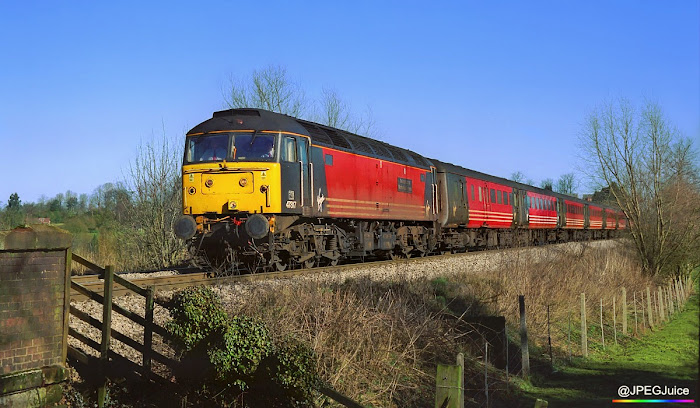
47817 became the first ILRA Class 47 to break free from the InterCity Swallow stranglehold, when it gained Porterbrook’s purple/white house colours in April 1996. Just over two years later in June ’98, it was outshopped in Virgin livery. The red and charcoal 47817 was not, however, named until autumn 1999, when 47841 The Institution of Mechanical Engineers was de-named, then renamed Spirit of Chester. At that point, ‘817 acquired ‘841’s old name – The Institution of Mechanical Engineers – secondhand. 47817 worked for ILRA into mid 2002, before being absorbed into the Thunderbird programme with an allocated ID of 57311.
47818 Strathclyde

47818 first rocked into traffic in Virgin livery in January 1999. It initially ran without a name, but was christened Strathclyde in a ceremony at Polmadie open day in September 2000.
Virgin’s ‘Eights were based and maintained at Crewe up until 15th March 1998, at which point they all moved as a group to Toton. The mass transfer was billed in some magazines as a measure to ease the workload at Crewe, but it was much more likely prompted by the Virgin/Bombardier deal, first announced earlier that month. To sweeten the major DEMU (subsequently Voyager) order for Virgin, Bombardier had undertaken to “dramatically improve” the reliability of the ILRA 47s. And even at this early stage they were rumoured to have specifically chosen the Toton-headquartered EWS as their subcontractor in achieving that aim.
47822 Pride of Shrewsbury

Only four of the Virgin red 47/8s had their ETH plugs located above the buffer beams on the base of their cab fronts, and 47822 was numerically the first of them. The loco went Virgin red early in 1998, but was not named until 25th May that year, when it was dedicated Pride of Shrewsbury, at Shrewsbury station.
‘822 was another of the original 'gang of four', earmarked for Class 57 conversion in October ’01. After struggling through February 2002, Pride of Shrewsbury was given a Royal send-off (sort of) at the end of the month, when 47798 Prince William towed it to Loughborough on its final journey as a 47. As the Virgin Class 57s were still projected as 57/6s at that point in time, ‘822 was not allocated its correct new ID – 57305 – until the spring.
47827

47827 was notably the scheduled train engine for the 1M20 Paddington – Birmingham of Wednesday 23rd July 1997. Why is that notable? Because this was the train that saw ‘Deltic’ D9000 dropping a bombshell into rail history and returning to service work – the first time any ‘Deltic’ had powered any service train since the end of their BR service in the early 1980s. InterCity 47827 did appear on the train as scheduled, but was topped by the ‘Deltic’, which provided the tractive effort.
‘827 subsequently lived a ‘wallflower’ life as a Virgin red 47/8 (repainted autumn 1998) with no name. It was, however, one of the first four Virgin Class 57 candidates, identified in early October 2001, worked its last ILRA duty at the end of that month, and assumed the identity of 57302 in 2002.
47828 Severn Valley Railway

In late April 2001, 47828 attended the SVR diesel weekend ex-works in Virgin red, with red buffer beams, silver buffers and white wheel rims. The event, attended by Virgin’s Chris Green and a raft of railway press luminaries, saw the loco named Severn Valley Railway, and was also used to invigorate enthusiasm in the 47/8s.
Up until that point, Virgin’s ‘Eights had largely been blind-eyed by loco fans. But placing a pristine example at the top of the Saturday billing, double-heading it with ‘Hoover 35’, then announcing a programme of celebrity repaints and namings, got the 47/8s plenty of magazine coverage. The coverage, which also stressed how little time the ILRA locos now had left in frontline service, undoubtedly heightened interest in the fleet.
47829

Another of the 1990s red repaints that spent a comparatively long time being blind-eyed as an anonymous member of the ILRA fleet. 47829 became a star after it was unveiled in Police livery in late March 2002. Although the Police livery was part of a West Midlands BTP anti-trespass/vandalism campaign, and the loco was used to haul an observation saloon around West Midlands vandalism hotspots on the day of launch, it essentially continued to work as a normal ILRA loco forward from the 06:05 Derby – Plymouth of the following day. 47829 was one of the Freightliner Heavy Haul transfers in May 2003.
47831 Bolton Wanderer

The late 2000 / early 2001 period saw a small glut of 47s emerging in Virgin red, and 47831 was among the locos involved. Bolton Wanderer had its formerly red nameplates revised into black at the point of the repaint, and was in fact the only existing namer in the fleet to retain its name and have its red plates repainted black. ‘831 continued running as an ILRA loco into mid 2002, by which time it had already been selected as the shell for 57310.
47839 Pride of Saltley
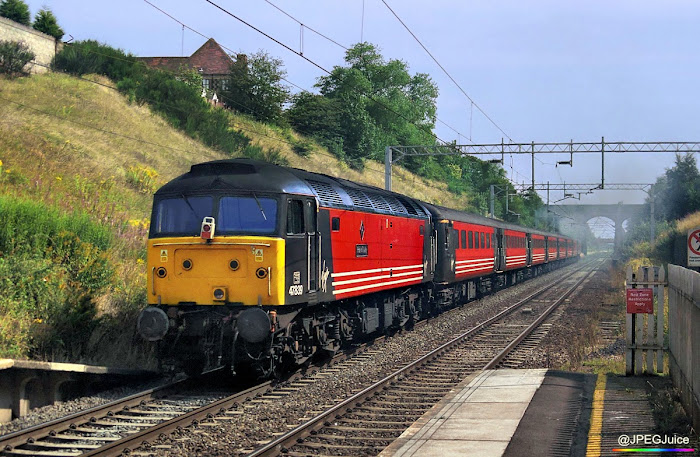
47839 survived in InterCity livery until the winter of 2000-2001, then emerged in Virgin livery, initially unnamed. It gained its Pride of Saltley plates and accompanying diamond-shaped plaques at Toton’s triple-naming event on 6th February 2002.
‘839 was one of the examples that made it past the end of the CrossCountry loco-hauled timetable in mid August 2002. Virgin 47/8s that were still active after this timetable change were immediately absorbed into a regime of Voyager-replacement cover duties, since not all of the Voyager fleet was yet available for use. The Voyager replacements routinely ran top and tail, but only to avoid shunts at termini. Only the front 47 would provide power in any given direction. The loco-hauled vice sets were announced at stations as Virgin Voyager services – normally with an apology for the almost inevitable late running.
47840 North Star

47840 saw out the twentieth century not only in InterCity livery, but also still in possession of its very retro North Star nameplates – in a style that had started to look old-fashioned even in the era of steam heating. Gladly, when repainted in Virgin colours during the summer of 2000, the former WR slogger retained its name and nameplate style.
In May 2002, North Star emerged in Rail Blue as the last of Virgin’s heritage Class 47 repaints. This placed the loco into a special category for the ensuing months of service, as Virgin consciously used “celebrity” 47s on certain trains – in a similar manner to the way they’d used the ‘Deltic’ in the 1990s. This not only applied to one-off specials, like the loco-hauled finale runs (in all of which 47840 played a part), but also some regular weekend services like Virgin West Coast’s Saturdays only Manchester – Paignton.
47841 Spirit of Chester
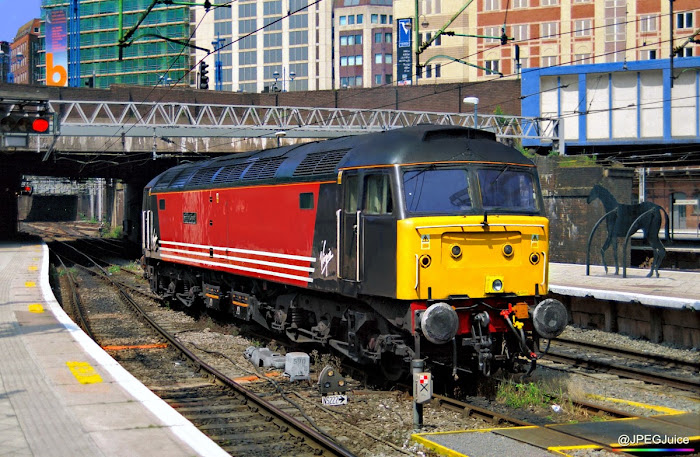
It seemed rather odd that 47841 should have been stripped of its old name and given a new one in September 1999 – especially when the majority of the fleet were still anonymous. However, namings would normally be expected to coincide with a repaint, and mainly due to a bottleneck caused by Toton's paint shop renewal, no other Virgin 47/8 was repainted between January 1999 and January 2000. So it was probably a case of seizing an opportunity to schedule the previously postponed Spirit of Chester naming ceremony whilst an ex-works Virgin red loco was available.
The de-naming could also explain the fitting of ‘841’s new Spirit of Chester nameplates at the ‘wrong’ end of the body. The loco’s old The Institution of Mechanical Engineers plates were still in place in summer ’99, and given the apparently opportunistic nature of the renaming, it may have been that the new Spirit of Chester plates were attached before the old plates could be prized off the bodysides.
47843 Vulcan

47843 was one of the Virgin Class 47s re-united with its old name in summer 2000. It was repainted Virgin red a few days before the (re)naming and did very briefly operate in the livery without its Vulcan plates. There had been no naming ceremony when the plates were restored in the July, but in a clever bit of opportunism, Vulcan’s renaming was jumped upon as a convenient event-headline for the Old Oak Common open weekend on 5th August. With the loco still looking ex-works, it could be “officially re-united” with its name for the crowds, without too many people realising they were renaming a loco which had already been renamed.
47843 survived beyond the end of the XC loco-hauled timetable, and joined Freightliner Heavy Haul in 2003.
47844

One of the very early Virgin red repaints, appearing ex-works in July 1997, and as such, repainted at Crewe rather than Toton. There were no consistent defining features to distinguish a basic Crewe repaint from a basic Toton repaint. However, Toton’s repaints fell into an era which was rather more celebratory of the 47/8s, so flamboyant touches like red buffer beams and/or silver buffers became more likely during the Toton phase.
In 2002, ‘844 ended up in the SBXL Class 57 conversion pool, allocated the future identity of 57307. However, as was also the case with 47849, the shell was found to be unsound, and 47225 was brought in as a substitute, with 47844 sadly going for scrap.
47845 County of Kent
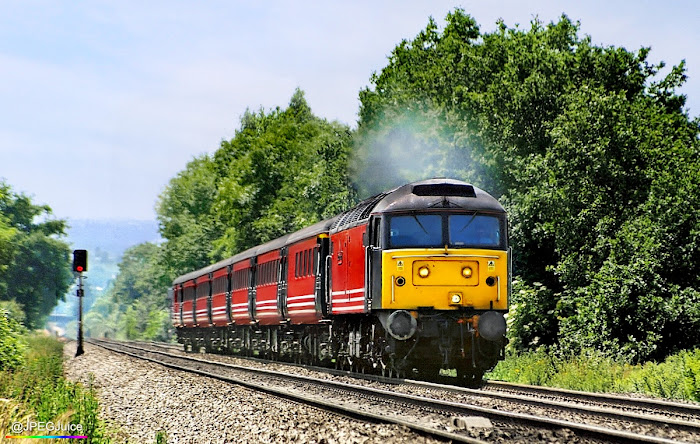
47845 County of Kent was originally “the loner” in Virgin’s ILRB pool (see text for 47814), but was switched with 47825 in December 1997, and joined ILRA for the rest of its working life as a 47. ‘845’s Virgin colours were applied at the time of the pool switch.
County of Kent worked its last train with a Sulzer engine on 11th October 2001, at which point it was taken out of service and sent to Loughborough – the intention being to use it as the shell for the first Virgin Class 57. However, because the Virgin 57s were being projected as 57/6s at this time, and not 57/3s, the initial number allocated was 57602 – the first available in the /6 series after Great Western’s 57601. Even though inactive, 47845 remained in the ILRA pool until 4th February 2002, when it was placed in the SBXL Class 57 conversion pool. It emerged as 57301 in mid June 2002.
47847

47847 spent the shortest time in Virgin colours, having gone into 2001 wearing InterCity livery, then appeared in red and charcoal that spring, but then lost the ‘Kit-Kat’ livery again in the autumn when it became a large logo blue celebrity.
In the early privatised era, there were only two significant operators of 47/8s – the other being Great Western Trains, subsequently First Great Western. FGW had a much smaller 47/8 fleet than Virgin. Including the reserve of one loco, their fleet comprised: 47811, 47813, 47815, 47816, 47830, 47832 and 47846.
There was a clue in each of Virgin’s Class 47 celeb repaints, that the loco was not foreseen as an inclusion in the Thunderbird conversion programme. True to the theory, 47847 survived as a 47, moving to Freightliner Heavy Haul in 2003.
47848 Newton Abbot Festival of Transport

Scruffy InterCity 47848 was repainted Virgin red in May 2000, to coincide with its naming. Like 47828 and 47849 – both also repainted in connection with a naming – it was given red buffer beams. The gleaming beast was named Newton Abbot Festival of Transport immediately after its Virgin repaint. To mark the naming, it was then actually driven on the 08:48 Penzance – Manchester service of Saturday the 13th, by the Mayor of Newton Abbot, in full mayoral regalia. Fortunately for passengers, the Mayor of Newton Abbot was also a Plymouth-based Virgin driver.
47849 Cadeirlan Bangor Cathedral

Who would have believed, in spring 2000 when 47849 exchanged its battered InterCity guise for this sparkling coat of Virgin red, complete with brand new nameplates, that it would be completely cut up just over two years later? Cadeirlan Bangor Cathedral caught fire at Kenilworth whilst working the 1M81 Bournemouth – Manchester in December 2001. After spending the night in the loop at Kenilworth, the sorry specimen was towed to Saltley, and subsequently on to Loughborough, where a period of flux began. To the surprise of some, in February 2002 ‘849 was actually placed into the SBXL Class 57 conversion pool. But before it could be allotted a 57/3 identity, it was ruled unsuitable and very promptly sent for disposal. It was fully cut by early May 2002.
47851
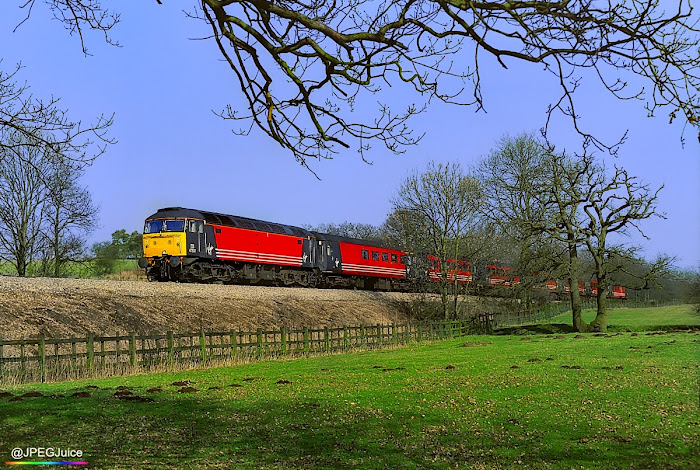
Anonymous 47851 clung onto its InterCity garb through 2000, but sported Virgin red by early 2001. As a last-minute reserve in the heritage livery programme, it stole 47806’s glory with a BR two-tone green repaint in November 2001. This eleventh hour change actually diminished the urgency for photographers who sought photos of the Virgin red 47s. Since it was expected in summer 2001 that 47851 would retain its fairly new Virgin livery until the end of the loco-hauled timetable, there seemed no immediate rush to grab photos of it. Indeed, some of us specifically chased ‘806, since that was the one which had been identified to go green. But when the impromptu switch occurred, we were left reflecting on some missed opportunities re the red 47851.
47853
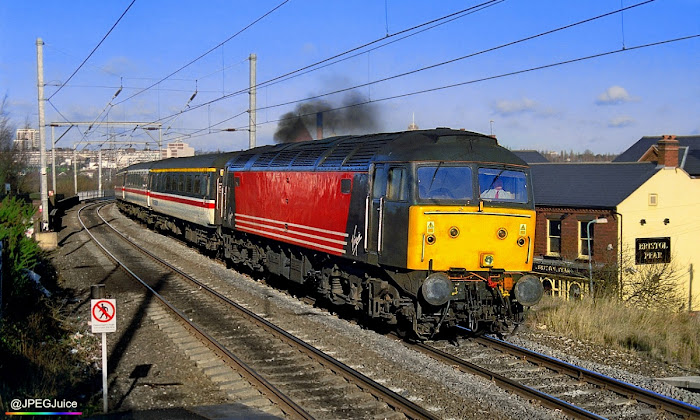
Released from a Toton Super E exam wearing Virgin livery on 5th January 2000, exactly three years after the operator’s launch, 47853 was only the tenth 47/8 to wear the red and charcoal house colours. This livery lasted until 22nd November 2001, when the former D1733 disappeared into Toton for its far more famous XP64 repaint. The heritage livery programme was choreographed, so the locos were not necessarily due any other works attention when sent for their aesthetic makeovers. That meant they could be back out of works within a week, as was the case with ‘853.
47854 Women's Royal Voluntary Service

Finally released in Virgin colours in spring 2001, 47854 Women's Royal Voluntary Service had been among the eleventh hour InterCity Swallow survivors. If you saw the previous post, you may be interested to know that when 47854 suffered a main generator fire on 10th December 1999, whilst working the 09:10 Edinburgh – Bournemouth, it was rescued at Reading by one of the ‘Sandite Syphons’ – 37230. No Virgin red Class 47/8 was given new red nameplates. All ILRA members newly named under Virgin had black plates. The red plates were a hangover from the InterCity era, and they looked markedly better on the old falcon grey bodyside than they did on red.
ID GUIDANCE AND KEY FOR DETAILS BLOCK
Identifying an unidentified Virgin red 47/8 in photos from its time in Virgin red is often highly possible. Particular areas of variation would include the type of marker light panels, and the number of lamp mounts on the cab fronts. The height at which the nameplates were fitted is another telling trait, in conjunction with the plates’ size, whether they were accompanied by plaques, etc. However, some examples ran in Virgin colours both without, and then with nameplates – which complicates things.
Other variations included the heights of the ‘Virgin’ logos, which are easy to measure using the three white bodyside stripes as a guide. And another good ID component was the height above the tail lights at which the overhead warning plates were set on the cab front. The heights of these plates were pretty consistently from end to end, so the heights you see in the photos will likely apply to the other end of the loco too.
Some of the above is noted in each loco’s Details block, and some is better gleaned from looking at the photos. I’ve also used a Quick ID panel to draw attention to the most obvious means of identification – although not all locos in the fleet were straightforwardly distinguishable.

If available, the ILRA Class 47s were used for Euston ‘drags’, when electric-hauled services between Rugby and Birmingham were diverted via Nuneaton. Here at Castle Bromwich on 16th July 2000, 47841 Spirit of Chester drags 87025 and its West Coast stock set.
Here’s the key…
CAB FRONT DETAIL KEY
The No.1 end is the end with the opening and closing vents on the roof.
F – Recessed, plated headcode panel with flush, ring-bounded marker lights.
H – Recessed, plated headcode panel with headlight-type marker lights.
R – Re-skinned cab front with headlight-type marker lights (no recess).
N – Non-standard plated headcode panel with headlight-type marker lights on raised flatwork.
E – ETH plug mounted above buffer beam on base of cab front.
B – ‘Soft rectangular’ buffers.
W – Wide-spaced foot-steps at base of cab front.
{} – Both lower lamp mounts.
{ – Left hand lower lamp mount only.
} – Right hand lower lamp mount only.
NAMEPLATE KEY
Y – Carried nameplates throughout its time in Virgin livery (black plates).
Yr – Carried nameplates throughout its time in Virgin livery (red plates).
Yw – Carried nameplates throughout its time in Virgin livery (white plates).
P – Carried nameplates for part of its time in Virgin livery (black plates). Will denote month and year that plates were fitted.
X – Did not carry nameplates whilst in Virgin livery.
1 – Name occupied single row of text.
2 – Name occupied two rows of text.
Qd – Nameplates had separate plaques (diamond-shaped).
Qo – Nameplates had separate plaques (round).
Qs – Nameplates had separate plaques (square).
Qi – Nameplates had separate plaques (shield-shaped).